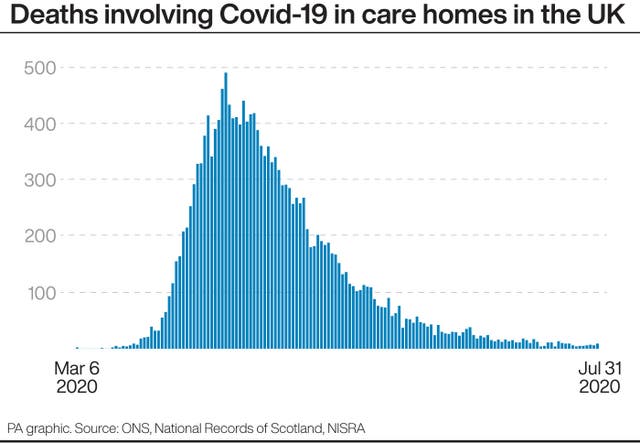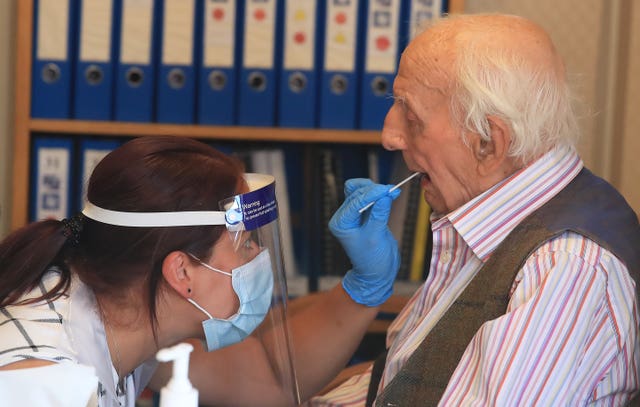
More than 400 deaths involving Covid-19 occurred each day in UK care homes at the height of the coronavirus outbreak, new analysis shows.
There were more than 3,000 care home deaths involving coronavirus in one week in mid-April, according to the first UK-wide review of daily deaths by the PA news agency.
Deaths rose five-fold between the start of the month and the care home peak on April 17, when nearly 500 residents died.
At this time, testing for all staff and residents – regardless of symptoms – was not available in England, Scotland, Wales and Northern Ireland, while providers had not yet been advised to restrict staff movements between homes.
Carl Heneghan, professor of evidence-based medicine at the University of Oxford, believes staff movement was of “huge” significance in aiding infection spread in the absence of effective testing.

Thousands of hospital patients were discharged into care homes from mid March, and there were struggles to access personal protective equipment (PPE).
PA analysed data from the UK’s statistics agencies to reveal the day-by-day death toll up to the end of July.
It comes ahead of Sunday – six months since the first care home resident death involving Covid-19 – and also found:
– More than 400 deaths involving Covid-19 took place in UK care homes on 11 days in April.
– Deaths increased more than five-fold in just over two weeks, from 93 on April 1 to 490 on April 17 – the highest daily total.
– By April 26, when the first UK nation announced that providers should restrict staff movements, 9,074 care home deaths had occurred across the UK – 51% of the total up to July 31.
– By April 28, when the first UK nation announced testing for all care home staff, regardless of symptoms, 9,776 care home deaths had occurred across the UK – 55% of the total up to July 31.
England’s chief medical officer Chris Whitty said in July “major risks” in social care settings were not considered early on, including staff working in multiple residences and those not paid sick leave.

Asymptomatic testing was first announced in England on April 28, despite Public Health England (PHE) saying it was a concern from the end of March.
The first nation to advise care home providers to restrict staff movements between homes was Northern Ireland, on April 26.
There was a gap of around two months between guidance from PHE advising care homes to share workforces in mid-March, to fresh advice to restrict staff movement announced on May 13 alongside funding to control infection spread in care homes in England.
Prof Heneghan said this was due to a lack of clinical experience in the Government’s advisory team and an absence of leadership.
Acknowledging care homes faced high levels of staff off-sick or self-isolating, he told PA: “The Government should have advised that agency staff, if used, should be employed in a single care home and not travel between multiple care homes. That advice should have been given in the middle of March.”
This should have been accompanied by funding to increase staffing levels, he added.
He believes this should be applied going into winter, but has seen no “sense of urgency” about protecting care homes.
Care England chief executive Professor Martin Green said guidance has been “slow to come to fruition” and addressing this, particularly with regards to visits, is a matter of urgency.

He said: “Many care homes locked down before national guidance came into force.
“Unfortunately patients were discharged from hospital without testing and this, compacted with insufficient PPE, created huge challenges for care homes.
“Routine testing is absolutely essential in order to establish confidence in the system for residents, staff, relatives and beyond.”
The potential risks of staff movement were first discussed at a meeting of the Scientific Advisory Group for Emergencies (SAGE) on April 21.
Dr Ian Hall co-authored the paper discussed, which was not made public until June 19.
The University of Manchester academic told PA concerns around staff movement should have been made public as soon as possible and that, given capacity issues, he believes staff should have been prioritised for testing over symptomatic residents.
But he said: “What we weren’t aware of at the time back in April and May was the complexity of the staffing situation, and so one of the concerns was, I know, ‘if we go too hard on the potential for staff being a vehicle for transmission, then a lot of staff might be absent and that might affect the care needs of the otherwise healthy but vulnerable residents’.
“So it’s a very delicate balancing act between trying to limit infection introduction and ensuring care is still provided.”
MHA, a UK care home provider, said mistakes must not be repeated and called for more funding, regular tests and “no slip ups or delays”.
Chief executive Sam Monaghan said: “What this analysis does is confirm that during the peak of the virus the sector, despite following all of the best infection control measures, were not supported with what turned out to be the additional critical tools we needed to manage the spread of the virus.”
Unison senior national officer Gavin Edwards said social care must be treated as an “essential public service” with pay and workforce conditions prioritised, to avoid a repeat of the first wave.
He said: “Social care workers are often paid poverty wages, employed on zero hours contracts and given no sick pay. In addition, many have faced a massive drop in income if they follow guidance and self-isolate. This clearly helped to drive infection rates in the sector.”
A Department for Health and Social Care spokesman said: “We have been doing everything we can to ensure care home residents and staff are protected, including testing all residents and staff, provided 200 million items of PPE, ring-fenced £600 million to prevent infections in care homes and made a further £3.7 billion available to councils to address pressures caused by the pandemic – including in adult social care.
“As a result of actions taken, almost 60% of England’s care homes have had no outbreak at all and the proportion of coronavirus deaths in care homes is lower in England than many other European countries.”


Comments: Our rules
We want our comments to be a lively and valuable part of our community - a place where readers can debate and engage with the most important local issues. The ability to comment on our stories is a privilege, not a right, however, and that privilege may be withdrawn if it is abused or misused.
Please report any comments that break our rules.
Read the rules here